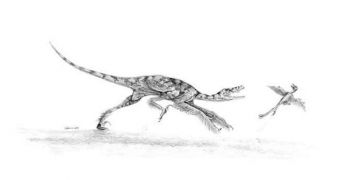According to amounting body of pieces of evidence, it may be that dinosaurs that lived in the late Cretaceous period were venomous, packing the dangerous chemicals inside their fangs. This is especially true for the saber-toothed relatives of velociraptors, which are considered to be among the ancestors of modern birds. The new pieces of evidence seem to suggest that lizard, snake and dinosaur venom all originated in the same species, LiveScience reports. The finding that led to this conclusion was made in northeastern China, and the animal discovered was dubbed Sinornithosaurus, or the “Chinese bird lizard.”
This snouted dinosaur, which lived about 125 million years ago, was the fifth species found to resemble modern birds, and is also the most bird-like of all. It lived in warm and moist forests, and its distinguishing mark is a very narrow snout. “This is an animal about the size of a turkey. It was almost certainly feathered. It's a very close relative of the four-winged glider called Microraptor,” scientist Larry Martin, who is also a University of Kansas Natural History Museum curator of vertebrate paleontology, says.
Evidence that the animal might have had venom in its teeth was discovered indirectly. The team learned that the lizard featured elongated and grooved fangs, and also that it had pockets inside the bones of the upper jaw. Experts believe that these empty pockets might have held venom. Over the millions of years it's been buried in the ground, the fossil has lost all its organic material, so it's very difficult to determine if this was indeed the case. However, the idea stands as it is, other scientists add. One of the main arguments that the KU team has is the fact that small ducts connect the hollow spaces with the fangs directly, as if what was inside poured through the teeth. And this can only be venom.
“People are probably sorry they missed it, since it's so obvious,” researcher David Burnham, also a paleontologist at the Lawrence-based museum, adds. “When we were looking at Sinornithosaurus, we realized that its teeth were unusual, and then we began to look at the whole structure of the teeth and jaw, and at that point, we realized it was similar to modern-day snakes,” Martin shares. “This thing is a venomous bird for all intents and purposes,” he adds. According to the earliest investigations, the venom was not lethal. Rather, it was only used to shock and immobilize the prey.
The lizard then proceeded to subdue its prey, and kill it before it came out of the venom-induced shock. “You wouldn't have seen it coming. It would have swooped down behind you from a low-hanging tree branch and attacked from the back. It wanted to get its jaws around you. Once the teeth were embedded in your skin the venom could seep into the wound. The prey would rapidly go into shock, but it would still be living, and it might have seen itself being slowly devoured by this raptor,” Burnham concludes.

 14 DAY TRIAL //
14 DAY TRIAL //